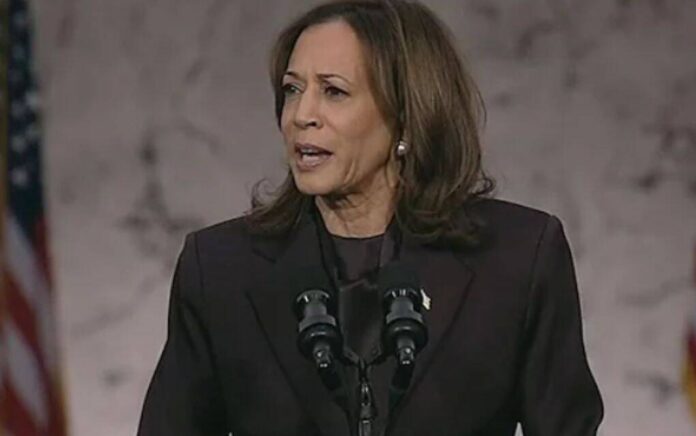
Harris’s defeat to Donald Trump has puzzled many Leftists. But now we know just exactly how she did it.
And Kamala Harris’s losing strategy has finally been revealed in a bombshell report.
In October, with just weeks to go before the 2024 election, word spread fast: Vice President Kamala Harris had shattered fundraising records, amassing over $1 billion. As reported by the New York Times, this fundraising achievement was remarkable for the sheer speed—just three months—over which it was accomplished.
But ultimately, it didn’t pay off. On Election Day, Donald Trump made history, becoming only the second former president to win a nonconsecutive term. After surviving two assassination attempts on the campaign trail, Trump dominated Harris in key battleground states, securing his place as president-elect—all with considerably less funding.
The story of Harris’s record-setting fundraising and her subsequent defeat is certain to be scrutinized by political strategists for years. Democrats, who had successfully pushed 80-year-old President Joe Biden to pass the torch to Harris, are now engaged in a postmortem on a campaign that saw Trump spending hundreds of millions less than Harris but still coming out on top.
“A billion dollars paled in comparison to the increased prices Americans were seeing across the country,” said Tom Fitton, president of the conservative group Judicial Watch and a Trump supporter. “Voters weren’t fooled,” he told the Washington Examiner.
Harris and her affiliated committees spent over $654 million on advertising between July and Election Day, a stark contrast to Trump’s $378 million, according to AdImpact data. Harris’s campaign leaned heavily on support from a major super PAC, Future Forward, which acted as an “ad-testing factory,” backed by major Democratic donors like Reid Hoffman, George Soros, Michael Bloomberg, and Dustin Moskovitz. A substantial portion of the campaign’s funding also came from anonymous, or “dark money,” sources—an irony, given progressive criticism of such donations in recent years.
The Harris campaign declined to comment on its spending. A more detailed account of the campaign’s finances will be available after the election, as the Federal Election Commission requires post-election financial disclosures.
As of mid-October, Harris’s campaign reported expenses totaling over $880 million—$526 million more than the $354 million disclosed by Trump’s team, per a Washington Examiner analysis. The Harris campaign’s expenditure spanned digital media advertising, polling, and extensive travel, including private jet services through Advanced Aviation.
Payroll was another major cost, totaling $56.6 million, which dwarfed Trump’s comparatively lean $9 million payroll expenditure. This difference reflected Harris’s larger staff, with hundreds more campaign workers.
Harris also poured funds into hiring a cadre of political, digital, and media consultants, spending over $12.8 million on these services, according to campaign filings. Notable among them was Village Marketing Agency, which received over $3.9 million to recruit social media influencers in support of Harris’s campaign. Other major consultancy contracts went to Precision Strategies, a Democratic marketing agency; Ethos Organizing, founded by former Ohio Democratic Party director Malik Hubbard; and SKDK, a PR firm closely aligned with Biden.
In the coming months, Harris’s spending on consultants is likely to be closely examined as Democrats seek to understand why the campaign struggled. Following Harris’s concession speech on Wednesday, former Democratic Sen. Claire McCaskill remarked on MSNBC that Harris “was listening too much to consultants,” arguing this may have prevented her from connecting authentically with voters.
“There was a segment of the electorate that was very consistently saying, ‘I’m not familiar with Kamala Harris,’ and, because of that, ‘I’m not comfortable enough to decide to vote for her,’ whereas Trump is incredibly well-defined,” said Jake Dilemani, a Democratic strategist. “It was easier for him to spend less and still win.”
Harris’s team also invested heavily in high-profile events and star-studded rallies. Campaign filings show that “event production” was a staple expense. The campaign spent over $15 million to stage rallies, including performances by Lady Gaga and Katy Perry on the night before the election. Oprah Winfrey’s Harpo Productions received a $1 million payment for an event on October 15, while Viva Creative, which has worked with Winfrey, Trevor Noah, and American Express, received $1.8 million. Other firms, like Production Management One, Vox Productions, Temple University, and Wizard Studios North, also benefited from the campaign’s event budget.
One notable production expense involved a set built for Harris’s October appearance on the popular Call Her Daddy podcast with host Alex Cooper, reportedly costing six figures. The Harris campaign did not comment on the specifics of this expenditure.
Reflecting on the campaign’s shortcomings, a Trump campaign adviser summarized bluntly: “Money can’t buy you love or a good candidate.” Brad Todd, a Republican strategist, echoed this sentiment, noting that the key to Harris’s defeat lay not in the size of her war chest but in her messaging.
“Advertising is a pretty important source of information for swing voters,” Todd explained. “It no doubt matters, but it’s not enough. It doesn’t matter if you have the wrong message and it’s not delivered in a compelling way. What her campaign was missing was any effort to break with the unpopular administration she has been a part of.”
In the end, Harris’s unprecedented fundraising proved to be an asset that simply couldn’t overcome the challenges of voter perception, message alignment, and the intense familiarity voters have with Trump.
Her billion-dollar campaign is a case study for the limitations of financial power in politics—offering lessons that may shape the strategies of future campaigns.
Stay tuned to The Federalist Wire.



















